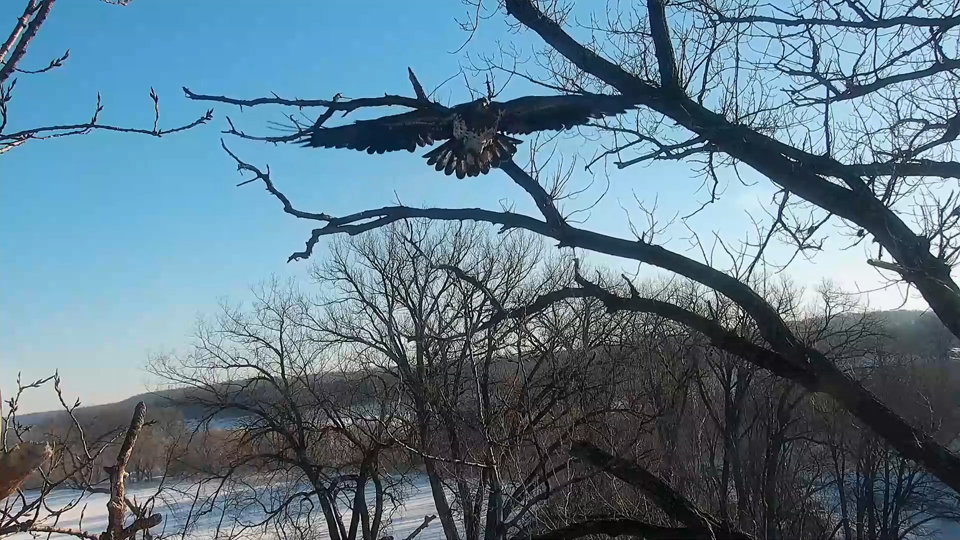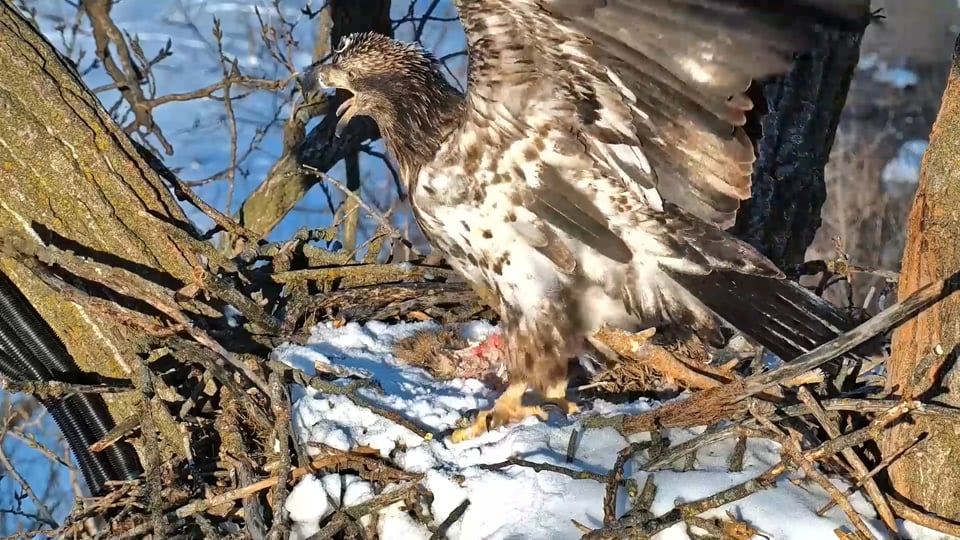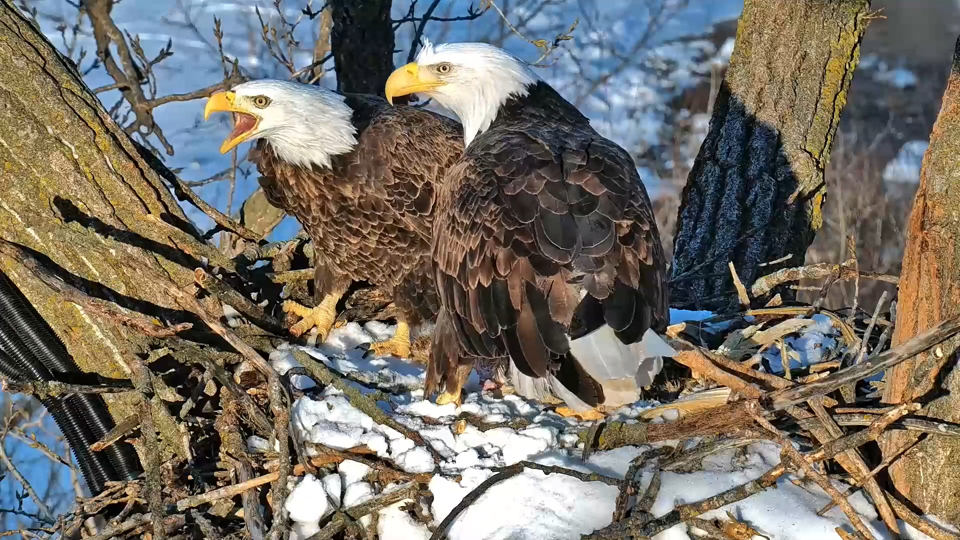Several persistent subadult eagles at the Decorah trout hatchery have watchers wondering if they are Decorah eaglets. One appears to be roughly 2-1/2 years old, which means it hatched in 2020: the last year that Mom and DM2 nested in N2B. We know it isn’t D35 or D36. Could it be D34?
Natal dispersal in birds is defined as the movement between hatching location and first breeding or potential breeding location. Juvenile bald eagles usually disperse from their natal nests in late summer or early fall. Generally speaking, young eagles wander more than older eagles, female eagles migrate farther than male eagles, and non-breeding eagles are more likely to migrate than their breeding counterparts. After an eagle’s first dispersal, it travels a regular route between its winter and summer homes, although it might shorten the trip in its first couple of years.
We know that our eaglets winter in northeast Iowa. Could the subadult eagles at the hatchery have originated in nest N2B? Let’s take a dive into the data!
What do our eagles tell us?
We tracked four eagles past their first year: D1, a female we tracked from 2011 to 2014; D27, a female we tracked from August of 2017 to November of 2022; and D36, a male eagle we tracked from August of 2020 to the present day. We tracked D24 past his first year, but his data set was sporadic enough that I didn’t include it here. You can learn more about all of our eagles here: https://www.raptorresource.org/learning-tools/eagle-map/.
Between November 1 and March 30:
- D1 (♀): We tracked D1 to within 1500 feet of the nest one time [https://goo.gl/maps/PHf8tKNayhytuEnJ8]. 56% of her hits occurred within 30 miles of N1 (185 of 330 hits). While her locations varied, we most commonly recorded her 6 to 10 miles from the hatchery nests.
- D27 (♀): We tracked D27 to within 1500 feet of her natal nest five times. Her closest approach was about 1100 feet [https://goo.gl/maps/726QYtFMibRjtk779]. 76% of her hits occurred within 30 miles of N2B (1,431 of 1,876 hits). While her locations varied, we most commonly recorded her 6 to 10 miles from the hatchery nests.
- D36 (♂): D36’s closest winter approach to his natal nest was 8.9 miles [https://goo.gl/maps/4N4CNW4pVsg8BwZb9]. Just 10% of his hits occurred within 30 miles of N2B (88 of 831 records). While his locations varied, we most commonly recorded him 20 to 30 miles from the hatchery nests.

February 2, 2023: A subadult eagle flies into N1
Subadult eagles are between two and five years old, which means that we can only consider eagles produced between 2019 and 2021. Mom and DM2 produced eight eaglets during that time: D32 and D33 in 2019; D34, D35, and D36 in 2020; and D37, D38, and D39 in 2021 (N3). The subadult we saw in N1 appeared to be about 2-1/2 years old based on plumage class, which puts hatch in 2020. D36 is banded and has a transmitter and D35 died of lead poisoning, so it would have to be D34, assuming it was a Decorah eaglet. But figuring out the likelihood is extremely difficult, since eastern Iowa is filled with eagles.
Location, Location, Location: Welcome to Bald Eagle Paradise!
Eastern Iowa is home to huge populations of breeding and wintering Bald Eagles. The Mississippi River and its tributaries have stretches of open water all year long, often nestled at the base of steep hills and bluffs that provide protected nesting, foraging, and roosting areas. Decades-long efforts to restore river habitat have resulted in cleaner, healthier rivers and more fish: the perfect habitat for eagles regardless of the season.

February 1, 2023: Another look at the subadult eagle in N1
These areas are valuable to breeding adults, non-breeding adults, and subadults. As any given eagle population grows and ages, it creates a pool of subadults and non-breeding adults that return to the same place year after year. While they might disturb local territorial breeders (get away from my nest!), they benefit eagles as a whole by providing a large, competitive pool of potential mates. In short: the more eagles you have, the more eagles you have, especially since eagles show strong fidelity to their natal regions and natal habitat types, and eagles attract more eagles.
Brett’s bald and golden eagle tracking studies demonstrate the interconnectedness between eagle populations residing in neighboring states and countries. Iowa or Ontario, our eagles spend a lot of time in habitats similar to their natal habitat type. These areas – eagle paradise, remember? – attract a lot of eagles. We know that eagles from Iowa, Wisconsin, and Minnesota summer in Canada, and eagles from Canada and the northern United States winter in the Driftless, along with Rough-legged Hawks, Golden Eagles, and the occasional Snowy and Great Grey Owl irruption. This means that management and conservation decisions in one area can have meaningful consequences for distant resident populations elsewhere. Why do we track Bald and Golden Eagles? The data they yield helps individuals and organizations make decisions that benefit them and many other species.
Visit our Maps page and click ‘winter maps’ to explore their wintering grounds for yourself!
How many eagles in Decorah are the offspring of Mom and Dad, or Mom and DM2?

February 1, 2023: HM and HD are not interested in visitors!
We don’t know the answer to that question because we don’t know how many eagles are reproducing in the Decorah area. But we can make a back-of-the-envelope guess about how their generations unfold! Let’s enter a fictional world where:
- Each eagle that breeds hatches its first clutch at six years of age.
- Each eagle produces three eggs each year and thirty-six eggs over its lifetime. Three of 36 eagles go on to breed as adults. The reproduction rate works out to about 8.3% of eagles, which is lower than most real-world estimates.
- Intra-family pairing isn’t factored in to keep the math a little simpler.
In this wonderful world of perfectly reproducing eagles, zero habitat limits, endless food, and frictionless carts, the Decorah Eagle Dynasty gets large quite quickly…
| Begins |
Generations |
Eagles Produced |
Breeders Produced |
| 2008 |
FD |
36 |
3 |
| 2014 |
Gen 1 [ABC] |
108 |
9 |
| 2020 |
Gen 2 [A2B2C2] |
324 |
27 |
| 2026 |
Gen 3 [A3B3C3] |
972 |
77 |
| 2032 |
Gen 4 [A4B4C4] |
2,772 |
231 |
| 2038 |
Gen 5 [A5B5C5] |
8,316 |
693 |
| 2044 |
Gen 6 [A6B6C6] |
24,948 |
2,079 |
| 2050 |
Gen 7 [A7B7C7] |
74,844 |
6,237 |
| 2056 |
Gen 8 [A8B8C8] |
224,532 |
18,711 |
| 2062 |
Gen 9 [A9B9C9] |
673,596 |
56,133 |
| 2068 |
Gen 10 [A10B10C10] |
2,020,788 |
168,399 |
Oh no! It took a while, but
Mom, Dad, and DM2 created the eagle apocalypse! In real life, populations don’t just continue doubling or tripling ad infinitum: members die before they reach maturity, skip reproduction, have poor reproduction, bump into limits imposed by competition, lack of food, or scarce habitat, or fall victim to a species-wide catastrophe that greatly reduces their numbers. Still, this scenario shows how quickly a population can grow under favorable conditions.
Mom and Dad were among the first bald eagles to nest in the Decorah area. Competition was low and conditions were extremely favorable. By our fictional world’s rules, their line should have produced about 750 members by now. While we can’t positively identify any given eagle as Mom, Dad, or DM2’s offspring, there is a very good chance that they are part of the Decorah dynasty! Remember to factor age in when you think about this: Dad’s youngest eaglets turn five this year, which means that all of them have reached maturity. Where does the time go?
Back to the subadult…
A study by the Biodiversity Research Institute in Maine found that eagles in their third year were more likely to visit the vicinity of their natal nest than any other age class. Both subadults at the hatchery can’t be Mom and DM2’s offspring, since only one 2020 alumnus is still unbanded and alive. But at least one of them is 2-1/2 to three years old: the age class that most commonly visits the old eagle homestead. Who is this? If it’s one of our eaglets, it must be D34.
References
 The Raptor Resource Project
The Raptor Resource Project The Raptor Resource Project
The Raptor Resource Project